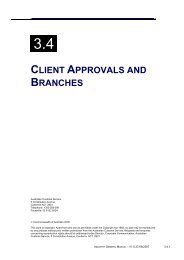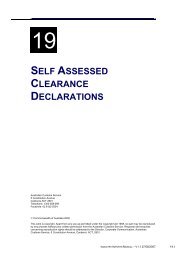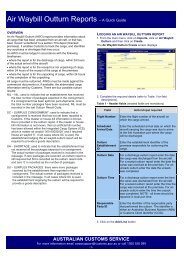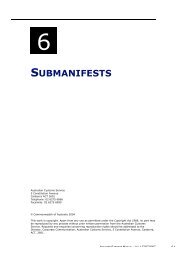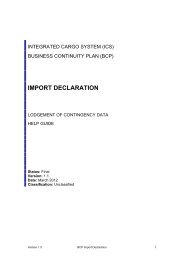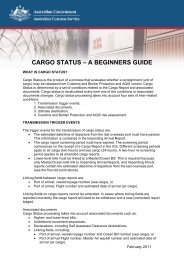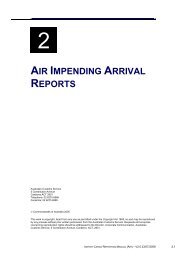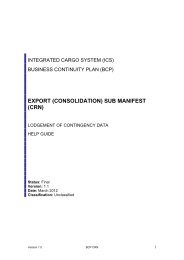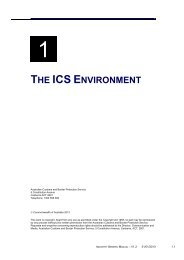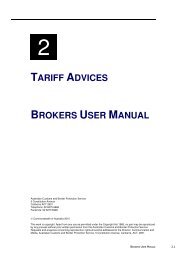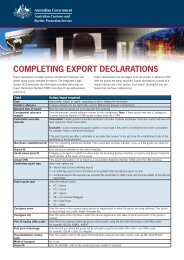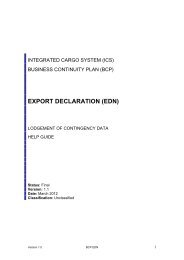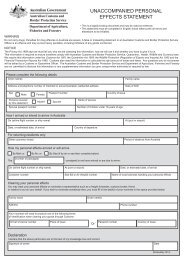Sea Cargo Inspection and Examination Arrangements - Cargo Support
Sea Cargo Inspection and Examination Arrangements - Cargo Support
Sea Cargo Inspection and Examination Arrangements - Cargo Support
Create successful ePaper yourself
Turn your PDF publications into a flip-book with our unique Google optimized e-Paper software.
Volume of <strong>Cargo</strong> Selected for Customs <strong>and</strong> Border Protection Intervention<br />
In the 2009/10 financial year, Customs <strong>and</strong> Border Protection’s target is to inspect 101,500 twenty<br />
foot equivalent units (TEU) <strong>and</strong> examine 14,000 TEU nationally.<br />
Selection of <strong>Cargo</strong> for Customs <strong>and</strong> Border Protection Intervention<br />
All sea cargo entering Australia is risk assessed, <strong>and</strong> where appropriate, Customs <strong>and</strong> Border<br />
Protection conducts further intervention on the cargo. All high risk cargo is inspected.<br />
ACCA 09/05 - <strong>Sea</strong> <strong>Cargo</strong> Status - Service Levels outlines the information that Customs <strong>and</strong> Border<br />
Protection requires before it can finalise the risk assessment for sea cargo, the timeframes it aims to<br />
complete the risk assessment within once all required information is available, <strong>and</strong> the services<br />
offered when those timeframes cannot be met. It also provides information on ways in which industry<br />
can assist Customs <strong>and</strong> Border Protection to minimise our impact on the sea cargo supply chain.<br />
Importers <strong>and</strong> exporters need to ensure they make provision in their reporting <strong>and</strong> logistics<br />
arrangements for the possibility of Customs <strong>and</strong> Border Protection selecting their cargo for<br />
intervention.<br />
Costs <strong>and</strong> Charges<br />
Section 186 of the Customs Act 1901 provides Customs <strong>and</strong> Border Protection with the power to<br />
examine any goods subject to its control. It has been determined that section 186 applies to the CEF<br />
logistics arrangements. The cost of presenting cargo for examination at the CEF is being recovered<br />
through the Import Processing Charge.<br />
As advised in Australian Customs Notice 2006/21 the current Import Processing Charges for sea<br />
cargo are:<br />
Item<br />
Electronic Import Declarations for goods imported by<br />
sea<br />
Documentary Import Declarations for goods imported<br />
by sea<br />
Current charge<br />
$50.00 (GST exempt)<br />
$65.75 (GST exempt)<br />
Damages<br />
Section 34 of the Customs Act provides that:<br />
Customs shall not be liable for any loss or damage occasioned to any goods subject to the control of<br />
Customs except by the neglect or wilful act of some officer.<br />
While Customs <strong>and</strong> Border Protection exercises appropriate care for all cargo, importers <strong>and</strong><br />
exporters should ensure that they arrange for the appropriate packing <strong>and</strong> insurance of their goods.<br />
The policy in regard to damages can be downloaded from Customs <strong>and</strong> Border Protection internet<br />
site at http://www.customs.gov.au/webdata/resources/files/CEFdamagesPolicy.pdf<br />
Contacting Customs <strong>and</strong> Border Protection<br />
All queries about matters addressed in this ACCA should be directed to the Customs Information <strong>and</strong><br />
<strong>Support</strong> Centre (CI&SC) by:<br />
• telephone on 1300 558 099<br />
• facsimile on (02) 8337 6713<br />
• email at cargosupport@customs.gov.au<br />
Customs <strong>and</strong> Border Protection will not provide information about specific consignments unless there<br />
are special circumstances, for example time-critical or hazardous consignments.



